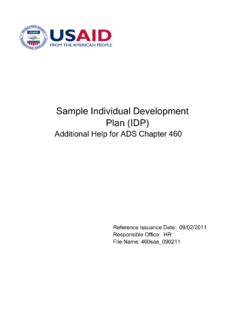Transcription of Conducting an Effective Flight Review - FAASafety.gov
1 Federal AviationAdministrationConducting an Effective Flight ReviewConducting an Effective Flight Review Table of Contents 1 Step 1: 2 Managing 3 Regulatory Flight 3 Step 2: Ground Regulatory XC Flight Plan Weather 4 Risk Management & Personal 4 General Aviation Security 5 Step 3: Flight 7 Physical Airplane (Basic Skills)..7 Mental Airplane (Systems Knowledge)..7 Aeronautical Step 4: Post Flight 9 Step 5: Aeronautical Health Maintenance & 10 Personal Minimums Personal proficiency Practice 10 Training Plan.
2 10 1 - CFI s Flight Review 12 2 - Pilot s Aeronautical 13 3 - Regulatory Review 14 4 - Pilot s Cross-Country 15 5 - Three-P Risk Management 16 6 - GA Security 17 7 - Personal Minimums 18 8 - Personal proficiency Practice 24 9 - Personal Training 25 10 - 26ii Dec05 Conducting an Effective Flight Review Acknowledgements This guide has been developed with assistance, contributions, and suggestions from a number of general aviation pilots and Flight instructors.
3 Special thanks are due to Pat Cannon, Turbine Aircraft Services; Jens Hennig, General Aviation Manufacturers Association; Sandy and JoAnn Hill, National Association of Flight Instructors; Sean Lane, ASA Publishing; Jim Lauerman, Avemco; Stan Mackiewicz, National Air Transportation Association; Arlynn McMahon, Aero-Tech Incorporated; Tim McSwain, USAIG; Rusty Sachs, National Association of Flight Instructors; Roger Sharp, Cessna Pilot Centers; Jackie Spanitz; ASA; Howard Stoodley, Manassas Aviation Center; Michele Summers, Embry-Riddle Aeronautical University; and Max Trescott, SJFlight.
4 It is intended to be a living document that incorporates comments, suggestions, and ideas for best practices from GA instructors like you. Please direct comments and ideas for future iterations to: Happy and safe flying! iii Dec05 Conducting an Effective Flight Review Introduction General aviation (GA) pilots enjoy a level of flexibility and freedom unrivaled by their aeronautical contemporaries. Airline, corporate, and military Flight operations are all strictly regulated, and each uses a significant degree of internal oversight to ensure compliance.
5 GA has relatively few of these regulatory encumbrances. As a result, safety depends heavily upon the development and maintenance of each individual pilot s basic skills, systems knowledge, and aeronautical decision-making skills. The purpose of the Flight Review required by Title 14 of the Code of Federal Regulations (14 CFR) is to provide for a regular evaluation of pilot skills and aeronautical knowledge. AC 61-98A states that the Flight Review is also intended to offer pilots the opportunity to design a personal currency and proficiency program in consultation with a certificated Flight instructor (CFI).
6 In effect, the Flight Review is the aeronautical equivalent of a regular medical checkup and ongoing health improvement program. Like a physical exam, a Flight Review may have certain standard features ( , Review of specific regulations and maneuvers). However, just as the physician should tailor the exam and follow-up to the individual s characteristics and needs, the CFI should tailor both the Flight Review and any follow-up plan for training and proficiency to each pilot s skill, experience, aircraft, and personal flying goals.
7 To better accomplish these objectives, this guide, intended for use in conjunction with AC 61-98A, offers ideas for Conducting an Effective Flight Review . It also provides tools for helping that pilot develop a personalized currency, proficiency , risk management, and aeronautical health maintenance and improvement program. A key part of this process is the development of risk management strategies and realistic personal minimums. You can think of these minimums as individual operations specifications that can help guide the pilot s decisions and target areas for personal proficiency flying and future training.
8 1 Dec05 Conducting an Effective Flight Review Step 1: Preparation Managing Expectations: You have probably seen it, or perhaps even experienced it yourself: pilot and CFI check the clock, spend exactly one hour reviewing 14 CFR Part 91 operating rules, and then head out for a quick pass through the basic maneuvers generally known as airwork. The pilot departs with a fresh Flight Review endorsement and, on the basis of the minimum two hours required in 14 CFR , can legally operate for the next two years.
9 This kind of Flight Review may be adequate for some pilots, but for others especially those who do not fly on a regular basis it is not. To serve the aviation safety purpose for which it was intended, therefore, the Flight Review must be far more than an exercise in watching the clock and checking the box. AC 61-98A states that the Flight Review is an instructional service designed to assess a pilot s knowledge and skills. The regulations are even more specific: 14 CFR states that the person giving the Flight Review has the discretion to determine the maneuvers and procedures necessary for the pilot to demonstrate safe exercise of the privileges of the pilot certificate.
10 It is thus a proficiency -based exercise, and it is up to you, the instructional service provider, to determine how much time and what type of instruction is required to ensure that the pilot has the necessary knowledge and skills for safe operation. Managing pilot expectations is key to ensuring that you don t later feel pressured to conduct a minimum time Flight Review for someone whose aeronautical skills are rusty. When a pilot schedules a Flight Review , use the form in Appendix 2 to find out not only about total time, but also about type of flying ( , local leisure flying, or cross-country flying for personal transportation) and recent Flight experience.











